|
FAQs about Blue-Green Algae
Identification 4
Related
Articles:
Blue-Green
"Algae"/(Cyanobacteria), Embracing
Biodiversity, Green Algae By Mark E. Evans, Green Algae, Green Algae 2, Avoiding Algae Problems in Marine System,
Algae
Control, Marine Maintenance,
Nutrient Control and Export,
Marine Scavengers, Snails, Hermit
Crabs, Mithrax/Emerald
Green Crabs, Sea Urchins, Blennies, Algae
Filters, Ctenochaetus/Bristle Mouth
Tangs, Zebrasoma/Sailfin Tangs,
Skimmers, Skimmer Selection, Marine Algae, Coralline Algae, Green Algae, Brown
Algae, Diatoms, Brown Algae,
Related FAQs: BGA Identification 1, BGA/Cyano ID 2, BGA/Cyano ID 3, &
Controlling: BGA/Cyano, Green Macro-Algae ID 1, Caulerpas, Green
Macro-Algae 1, Green
Macro-Algae 2, Green
Macro-Algae 3, Green Macro-Algae
4, Chlorophyte Behavior,
Chlorophyte
Compatibility/Control, Chlorophyte Selection, Chlorophyte Systems, Chlorophyte Nutrition, Chlorophyte Disease, Chlorophyte Reproduction/Propagation,
Marine Algae ID 1, Marine Algae ID 2, Marine Algae Control FAQs II, Marine Algaecide Use, Nutrient Limitation, Marine Algae Eaters, Culturing Macro-Algae; Red/Encrusting Algae, Green Algae, Brown/Diatom
Algae,
|
%20BGA%20Petco.jpeg) |
 |
New Print and
eBook on Amazon
Marine Aquarium Algae Control
by Robert (Bob) Fenner
|
|
White Hair Algae - Can't find a way to get rid of it!
9/22/15
Hi,
<Howdy>
I found you’re website off a forum and decided to give you guys a shot at trying
to ID this weird algae problem I have.
<Need to look under a 'scope.... see WWM, books I've written re.... My guess (w/
some confidence) is on Cyanobacteria... lack nucleus, plasmids,
plasmalemma........ >
I can’t find any resource on how to get rid of this particular type of algae so
hopefully you can provide me with some help!
Here is a link to the Algae ID FAQ where someone referred me to.
It looks just like the algae in the “Strange White "Hair" on Rocks” entry.
Here is the link and a few pictures of my tank.
http://www.wetwebmedia.com/MarAlgIDF33.htm
<Ahh! This one looks a bit different than "Jenny's"... again, simple exam will
likely show.... BGA>
I just need to know how can I get rid of this! I’ve had this in my tank for more
than a year! I’ve tried H202 but it keeps coming back.
Please help.
Thanks for helping!,
Vinoy
<The usual approaches: nutrient deprivation, competition, perhaps predation,
increased RedOx/ORP via water changes, Ozone/UV use, chemical filtrants of
use.... READ here:
http://www.wetwebmedia.com/bluegralgae.htm
"and the linked files above" (quite a jingle, eh?). Bob Fenner>
|
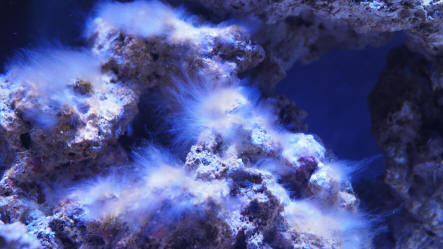
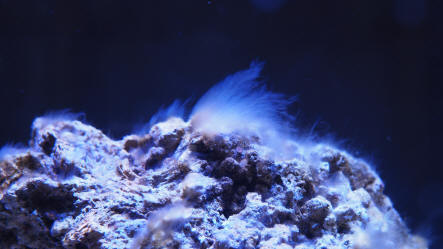 |
Difference between Calothrix and dinoflagellates?
1/5/15
Hello and happy holidays. I have a (hopefully quick) question: how can I tell
the difference between Calothrix and dinoflagellates?
<Mmm; well; the former, Calothrix, is a genus of multicellular Blue-Green Algae
(BGA), Monerans; more closely related to bacteria (Cyanobacteria) than the true
algae; which includes the single-celled Dinoflagellates. The only way to really
"tell" is to sample a bit and look at under a microscope... Both are best
controlled through nutrient deprivation...
which can be brought about in a few ways.... gone over and over on WWM.
Read there re>
I have what is, most likely, one of the two on my rocks, and I am not sure how
to tell the difference.
Thanks,
Steve
<Welcome. Bob Fenner>
Re: Difference between Calothrix and
dinoflagellates? 1/6/15
Thanks for the reply, Bob. I have been doing my best to deprive it of nutrients,
and I have been using Chemiclean and UltraLife red slime remover in
addition.
<Mmm; can be of use; though these antimicrobials are NOT my first choice/line of
attack. Again, SEE/READ on WWM RE>
Those products don't seem to be doing much, except that they seem to be making
the stuff extra stringy. But thanks for the info and I'll keep at it. I guess
that discerning the difference doesn't matter with regard to the treatment.
Thanks again,
Steve
Re: Difference between Calothrix and dinoflagellates?
1/6/15
For whatever it's worth, those two products don't contain any erythromycin or antibiotics.
<... see my resp. below.... what does it state? Antimicrobials>
I am fairly limited in the amount of techniques that I can employ because my
tank is an Innovative Marine
Fusion 20, which is an all-in-one with a rear chamber. I can run a small media
reactor/fluidizer and a small skimmer. There are a couple of chambers to run
sponges for mechanical filtration where I might be able to place small amounts
of other types of media.
<Stop writing and start reading. B>
Thanks,
Steve
|
Dinos! 11/4/13
Hi Crew!
I'm keeping it simple.
My reef tank is plagued with Dinoflagellates.
Someone told me NOT to use Kent's super buffer DKH to raise my pH.
<Mmm, the temporary raising of alkalinity (and pH along with... to 8.6 or
so) is a useful technique (and safer than other means) to remove
(insolubilize) phosphate>
As part of my plan to rid my tank of this algae, I am;
a.. Keeping lights on for only 3 hours a day.
b.. Raising pH from 8 to 8.4
c.. lessening organics, waste,
d.. using gfo and gac
e.. dosing Kalk day and night.
<Oh, okay... may well do the same as using "super buffer">
I've read and read about this subject till I'm cross eyed.
So tired.
Any advice about the Kent's and what else i could use?
My source water is (ro/di)
Thank you!
Pam
<Really? Just not worry period. Dinoflagellates, Diatom "outbreaks" just
come and go of their own accord. Other than being a bit unsightly, they're
not problematical. Bob Fenner>
Re: Dinos!
Bob,...look at my rock! The "Dinos" are an inch thick!
<Mmm, the sand may be mostly Dinoflagellates, but not the rock... IF
interested, I'd take a sample under a 'scope... You have a larger "nutrient,
lack of competitor, predator... issue>
And the sand is thickening and becoming, "snotty," with bubbles attached to
thin threads raising upwards.
You still say don't worry? The may come and go, but in my case, they keep
coming and NOT going!
I forgot to mention, that this "friend" said the Kent's super buffer DKH,
releases CO2 into the water.
<? What? Even if so, not problematic>
Do you agree with that statement?
<No; what ingredient/s would do this specifically? Not Speedy (Alka
Seltzer)>
And, sorry, but,...you didn't quite answer my question,... what can I use to
raise my pH?
<... Read here:
http://www.wetwebmedia.com/marine/maintenance/maintindex.htm
Scroll down to Algae Control.... B>
|
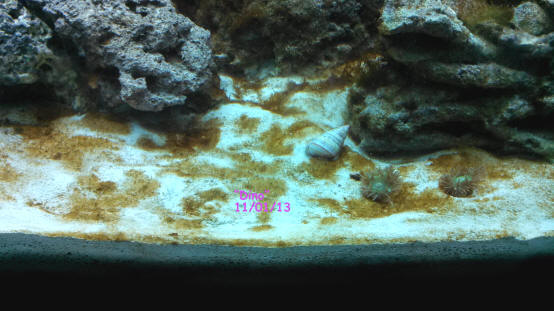
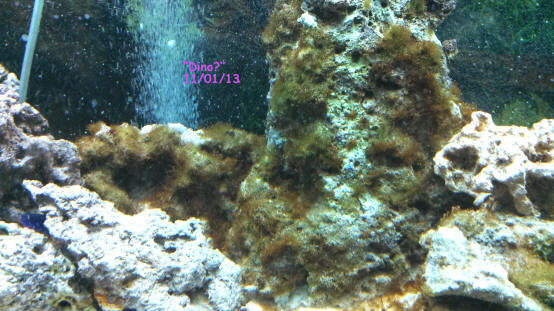 |
|
Re: Dinos! 11/4/13
Whoa! Nice link,...lots of reading!
Thanks!
Re: Dinos! 11/4/13
LOL Bob,... "our " friend, XXX told me that Kent's releases CO2 . and
not to use it!
So I guess I'd have to ask him "what ingredient/s would do this
specifically." :)
I don't have a scope, stethoscope yes, but not microscope,
unfortunately.
The rock also has the bubbles,
<Rapid photosynthesis by something...>
but I agree, it's not the same.
There is a massive "dead spot" in the sand bed that I'm going to siphon
out and clean.
<Good>
Maybe this will help a bit. Will also siphon the sand.
Thanks Bob, and please, don't publish this one, I don't want XXX to feel
bad that I went over his head!
<I will run it sans their name. B>
|
Last time Bob, I promise,...for now!
Found a GREAT picture that represents my sand!
Cyano, right?
<Most likely most of it yes. B>
|
| "borrowed" pic |
Re: Dinos!
11/5/13
Bob, am I on the right track by saying that Carbonic anhydrase, catalyzes
the hydration and the reverse reaction (dehydration) to allow organisms to
process carbon dioxide more rapidly that can lead to rapid photosynthesis?
<Yes... why do you ask?>
I read it here.
http://www.reefkeeping.com/issues/2006-10/rhf/ And am still
reading/ learning.
Pam
<Of what pertinence... B>
Re: Dinos!
11/6/13
Yikes, I feel really stupid now.
I asked because you said what seemed to be going on in my system
was;......"<Rapid photosynthesis by something...>
I 'm trying to figure out (the) "something"
<... Ahh, "is" the BGA>
I'm not a chemist ,just trying to understand the process.
Does the statement below have nothing to do with rapid photosynthesis?
"Carbonic anhydrase, enables organisms to process carbon dioxide more
rapidly "
<It does; as the biochemical pathway; mechanism. B> |
|
... SW... algae... induced BGA discovery; using WWM
9/24/13
Hi
hope U could slove my problem,
<... I as well>
I recently upgraded (changed) to 100G
(60"x18"x22") reef tank I used all the same old rock (50Kg/110lbs)
made all new saltwater and new sand 4" DSB in the tank + 4" DSB in sump
with old tank sand and Chaetomorpha. added only three fishes, pair of
common clown and one yellow tang, along with my corals. Tank kick
started never had any ammonia spike all gone smooth only nitrate
came till 15ppm for 1st month then went down now it shows zero
on API and Red Sea test kits.
(all fish and corals look healthy and active.)
now Problem is initially I had some diatoms + green/brown hair algaes
(could be Calothrix or dino flag.) what ever, reason PO4. I used
phosphate removers pads + JBL PhosEx by second month all hair algae from
rocks was gone some little still comes on glass which i
wipe and clean, but real nightmare is brown algae (its
not diatom coz diatom are powdery) this thing holds sand like
carpet I keep removing the layer and it comes back I tested for PO4 it
shows zero.
<Mmm, colour, qualities, absence of detectable HPO4... likely guess is
that this is actually BGA... See WWM re>
I'm using Brown Beach sand of Arabian sea does this sand leaches
something like silicates or phosphates if yes or could be,
then what should I do to control this coz as per my understanding
phosphate removers will only absorb phosphates which are in the water
column and this brown algae carpet locks phosphates or silicates within
it and if I keep on removing this layer I'm losing my DSB and adding new
sand will pour in new phosphates and silicates this problem looks like
never ending cycle to me.
I read your article really good informative, asking a question from that
how do I know that
<... is this English?>
If the calcium carbonate crystal is static (not growing), then this
process is reversible, and the aragonite can act as a reservoir for
phosphate.
<Not usually (under aquarium conditions); no>
This reservoir can inhibit the complete removal of excess phosphate from a
reef aquarium that has experienced very high phosphate levels, and may
permit algae to continue to thrive despite all external phosphate
sources having been cut off. In such extreme cases, removal of the
substrate may even be required.
Now removing substrate in 100g tank with 25pcs of coral is not an easy
task, its like disturbing the full cycle of the tank
I would prefer quitting this 5 year old hobby.
<?>
my head is full of advises from my fellow reef keeper like change the
bulbs of MH, switch over to LED, keep on doing water changes......
etc.... light is just one part of algae growth if no nutrients then what
ever the light spectrum there should be no algae how does PH factor act
upon this leaching of Phosphate and silicates from what ever source in
my tank..
<Doesn't... again, aquariums don't have "low enough" pH's to
resolubilize phosphate/s>
plz do advise on this matter
<On what matter?>
my para NH3:0, NO2:0, NO3:0 (<5PPM), PO4:0, PH:8.3, CAL:400,
ALK:8.5
LIGHTING: 2x 150W MH (12" above W/LEVEL) 3x30w (Actinic light)
<... see WWM re Actinic; of no use functionally>
Thnx Anis
<See WWM re Cyanobacteria... Bob Fenner>
|
Red bubble algae? 5/6/13
Is this red bubble algae?
<Nope. Appears to be Cyanobacteria aka blue/green algae>
I'm having difficulty identifying it. I also have a small patch of green
of the same looking algae on a different rock. Is it bad? If so, what
can I do to get rid of it? Any little creatures eat it?
<Read more here--
http://www.wetwebmedia.com/cyanocontrolfaqs.htm >
Thanks for all your help!!!!
<Quite welcome.>
Sent from my iPhone
<Sent from Jordan's laptop.>
|
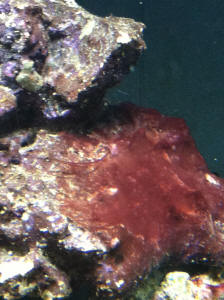 |
|
Red slime? /Jordan 5/21/12
Hi
<Hello John>
I am starting to get this blackish brown stuff on top of my sand and some
of it's turning a dark red... is it red slime/algae?
<Looks like it.>
And how do I take care of it?
<Lower nutrients, increase flow. Read more here--
http://www.wetwebmedia.com/bluegralgae.htm >
Will a cleaning crew take care of it?
<They will not eat the actual "slime" but they will eat excess food
which is fueling the growth.>
And what do you recommend I do?
<Read more on Cyanobacteria and lower available nutrients.>
Also is it dangerous for the tank?
<More of an eyesore but it can overgrow corals. It is a sign of improper
levels/excess nutrients.>
Tank is a 60gallon saltwater tank, 250 metal halide on for 7hr/day, all
water parameters normal and salinity <Specific gravity> at 1.025.
<Jordan>
Red slime? /RMF
5/21/12
Hi I am starting to get this blackish brown stuff on top of my sand and
some of it's turning a dark red... is it red slime/algae? And how do I
take care of it? Will a cleaning crew take care of it? And what do you
recommend i do? Also is it dangerous for the tank?
<Yes... almost certainly so... thanks to the 30-40k people using WWM who
search before writing us. See here:
http://www.wetwebmedia.com/CyanoIDF4.htm
and the linked files above. Bob Fenner>
Tank is a 60gallon saltwater tank, 250 metal halide on for 7hr/day, all
water parameters normal and salinity at 1.025.
|
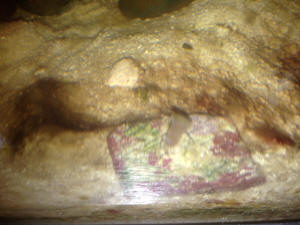 |
Cyano ?
3/12/12
Hi
A couple of months ago i sent in a picture and Bob said i had Cyano on
back wall of tank.
I have been fighting it since.
Increased water circulation 50% and reduced nitrates to 0.
I was scraping a little the other day and it comes off like flake fish
food. It actually looks like red flakes now too on tank wall.. Could
this be it dying maybe?
<Mmm, maybe... coming off in flakes doesn't "sound"
like Cyano... is this stuff slimy? BGAs are invariably so>
Frightened to scrape it as i tried this last time and fish were eating
it and a few died.
<Oh!>
Is this Cyano as i keep being told i should be able to either peel it
off or just hoover it up.
<I'd hoover while peeling>
Not this stuff. Scraping the only way.
Your thoughts appreciated as always.
Thanks
Gary.
<Again, I'd take a look under a scope... BGA being Monerans,
don't have nuclei.... definitive. BobF>
Re: Cyano ?
3/12/12
Thanks Bob
Not slimy at all but did look bubbly in parts.
If anything it just looks so dry, like flake and scrapes like dry
paint. Red in colour.
I tried hoovering while scraping but didn't have great success.
It is only on back wall of tank. Nowhere else.
My tank has grates on back wall where the water is sucked through.
This is where the main problem is.
Don`t know if any of this helps at all.
Gary
<Mmm, not much more. Again... microscope. B>
|
Algae? Problem
1/14/12
Hi all,
I work at a Petco
<As did I... starting their aquatics/livestock program
91-94>
and have run into a algae that I don't know what type it is.
Here is a picture of it.
<BGA, Cyanobacteria... can be very toxic. To be
avoided!>
It's a deep brown and only seems to like sand. Any idea what
type it is and the way to get it to go away?
<Yes; read here: http://www.wetwebmedia.com/bluegralgae.htm
and the linked files above>
Because its Petco I can't do RO water.
<There are other means, as you'll soon know>
Over this tank I run 2 t5ho 4 foot bulbs. They have been
running for 4 months but run on for 12 hours a day because of
Petco's hours. I'm working on replacing them. I do have
sps and lps corals in this tank which have done great and sell
well for over a year now. It doesn't look like the normal
Cyano bacteria that I've seen.
<Occurs in many colours, shapes... all slimy though!>
Any help you can give me would be great.
Thank you for your time,
Jason.
<And you for writing. Bob Fenner>
|
|
%20BGA%20Petco.jpeg)
|
 |
New Print and
eBook on Amazon
Marine Aquarium Algae Control
by Robert (Bob) Fenner
|
|
|

